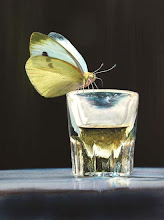So now it's spring, the season of growth and renewal, and we find ourselves bouncing along the bottom, one hopes, of the current economic slump -- the Great Recession, as some are calling it, or the Big Dip, if you prefer. Despite the current atmosphere of austerity and anxiety, it seems a perfect time for savvy art collectors to be doing some bargain hunting, especially at auctions and charity events, where low turnout amidst the new frugality means great deals on fine
art are waiting to be discovered. As it happens, I'm participating in two such upcoming fundraiser events...
Incognito at the Santa Monica Museum of Art
The first of these is
Incognito, the Santa Monica Museum of Art's annual fundraiser, at Bergamot Station on
Saturday, May 2, from 7 to 10 pm. This is a fun free-for-all of an art sale, featuring works by over 400 artists, some famous and some emerging, all the same size, all displayed anonymously, and all priced at just $300. In most cases, this
price is a small fraction of the work's market value, but the real pleasure of this event is watching so many people trusting their first glance, plunging into the unknown, and taking home as a result one or more fabulous artworks.
Because most of the work is sold within the first fifteen minutes, I recommend that anyone interested in buying tickets for this event should consider the Patron level in order to get priority admission, and come early in any case... The $600 Patron entry price for two includes one prepaid artwork ($300 value) and the rest is tax-deductable. Participating artists this year include John Baldessari, Kristin Calabrese, Ed Ruscha, Exene Cervenka, Meg Cranston, Urs Fischer, Salomón Huerta, Rebecca Morris, Leonard Nimoy, John Outterbridge, Raymond Pettibon, Allen Ruppersberg, Alison Saar, Eleanor Antin, and hundreds of others, including myself. You can see a video from last year's event
here... More information at
www.smmoa.org.
Venice Art Walk & Auction
I will also be participating in the Venice Art Walk Auction on Sunday, May 17, 11:30 am - 5:30 pm, at 1010 Abbott Kinney
Blvd in Venice.
This is another great chance to find bargains on high-quality art by a similarly distinguished lineup of contemporary artists, and admission to the silent auction is free... That is, you don't have to be a registered artwalk participant to stroll through the auction or to bid on any of the hundreds of artworks offered... You just need to find a place to park in Venice on a crazy busy weekend -- so ride your bike or bring the Smart Car. Proceeds from art sales benefit the Venice Family
Clinic.
My contribution to the auction (
Thick) is pictured below...
You can learn more about the event at
www.venicefamilyclinic.org.
 Thick
Thick, 2009, watercolor, 8 x 6 in.
Entomology show in Lincoln, NB
On the more distant horizon, my work will appear this July in "Salt Creek Environment: Local and Endangered," not a charity event but a conservation-themed exhibit at the Haydon Gallery in Lincoln, NB, which features 23 artists who have
completed works involving the endangered salt creek tiger beetle, one of the rarest insects in the world.
Organized by the entomology department at the University of Nebraska, Lincoln, the exhibit is funded in part by the Nebraska Environmental Trust, the Saline Wetland Partnership, and the Xerces Society.
Read more about salt creek tiger beetles at
www.xerces.org.
 Spotted
Spotted, 2009, watercolor, 20 x 15 in.
More images of recent work and other news at
www.paulpitsker.com.

